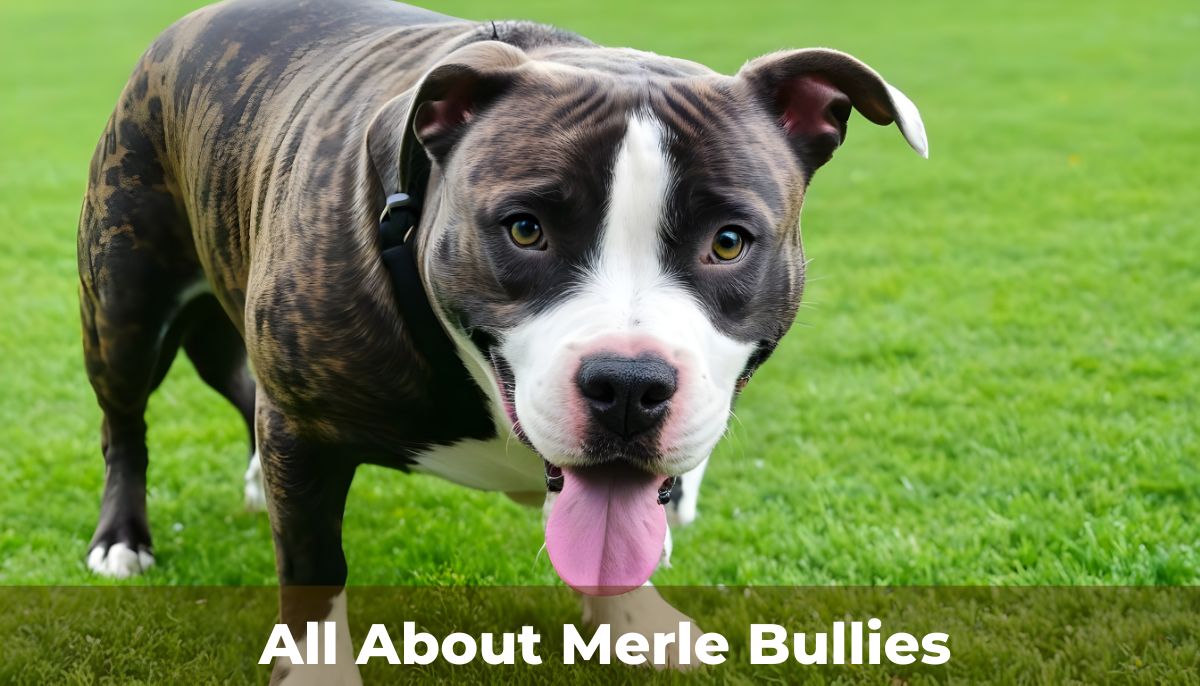Are you also one of those who love to know more about these canine companions and enjoy their captivating world? With over 15 years in the dog-loving game, I’ve witnessed the rise in popularity of these unique furballs.
Merles have a mesmerizing coat pattern, but their breeding has sparked some debate in the canine community. Join me on this exploration as we discuss the charm, concerns, and connections of Merle American Bullies, shedding light on their genetics, coat colors, and much more.
At a glance….
| Appearance | Striking |
| Temperament | Affectionate |
| Exercise | Energetic |
| Size | Varied |
| Intelligence | Smart |
| Lifespan | 10 to 12 years |
| Adaptability | Flexible |
| Socialization | Friendly |
| Trainability | Responsive |
| Health | Considerate |
What is a Merle bully?
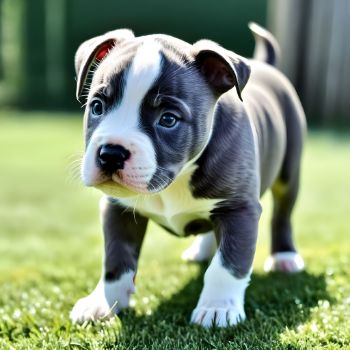
A Merle Bully is an American Bully with a unique coat pattern characterized by patches of diluted color, creating a marbled or mottled effect.
The term “Merle” doesn’t just refer to the coat but signifies a specific genetic trait.
We observe that this coat pattern results from the merle gene, which dilutes the dog’s base color, creating patches of lighter shade that swirl and blend.
These striking patterns add an extra layer of allure to these already eye-catching dogs.
Merle Bullies share fundamental characteristics with standard American Bullies, such as a muscular build and friendly disposition.
History:
The marbled coat in American Bullies is not a naturally occurring feature within the breed. This unique pattern emerged through genetic introductions from other breeds carrying the merle gene, like Australian Shepherds or Aussiedoodles.
The introduction of the Merle gene into the American Bully gene pool has led to the development of this unique variant. The Merle gene, responsible for the captivating patterns on their coats, results from a complex interplay of genetics.
This gene wasn’t initially present in the breed but was introduced through selective breeding. Breeders aimed to create a visually appealing coat variation, and thus, the Merle American Bully emerged. However, this breeding choice comes with its own set of considerations.
Merle Bully Genetics:
Unlike other coat variations, this unique pattern doesn’t naturally occur within the breed but results from intentional genetic introductions. This unique pattern arises from the complex interplay of genetics, specifically the Merle gene (PMEL17, also known as SILV).
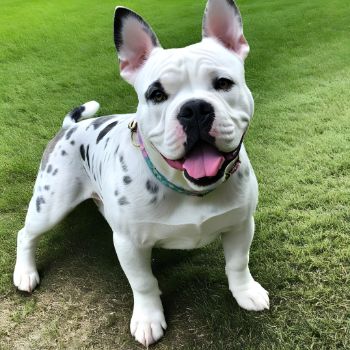
The Merle gene dictates melanin production, the pigment responsible for coat color. In dilute-coated American Bullies, the merle gene acts as a “diluter,” causing random patches of their base coat color to appear lighter, creating the characteristic marbled effect.
This dilution primarily affects eumelanin (black pigment), while pheomelanin (red and yellow pigment) remains largely unaffected.
With continued advancements in genetics and responsible breeding practices, this dog may become more widely recognized.
The unique pattern of the Merle Bully, akin to the intriguing tri-color bully variations, underscores the intentional breeding practices shaping the breed’s diverse coat patterns. Their names reflect their unique coat and personality and may become synonymous with the species.
How does Merle Bully acquire a Merle Coat?
The answer lies in genetics, specifically the M-locus gene. This gene has two variations: dominant (M) and recessive (m). A single dominant M allele is sufficient to produce the merle coat, while two recessive m alleles are needed for a solid-colored coat.
Did you know?
The Merle coat pattern can also occur in other dog breeds, such as Australian Shepherds and Border Collies.
The merle coat is characterized by irregular patches of color interspersed with lighter or diluted areas, creating a mottled, swirly pattern.
This mesmerizing effect occurs due to a specific gene variant, M-locus. This variant affects the distribution of melanin, the pigment responsible for fur color, resulting in the characteristic merle pattern.
Characteristics of Merle American Bully:
Beyond the captivating swirls of color that define their merle coat, the American Bully boasts a distinct physical presence.
• Size and Structure:
These dogs typically have a medium to large size, with a solid and muscular build. Their physique is well-balanced, reflecting the breed standard for American Bullies.
• Head and Skull:
The American Bully head is large and boxy, with a broad muzzle and pronounced cheek muscles. The skull is deep and well-proportioned to the body, adding to its powerful appearance.
• Ears:
The ears of Merle American Bullies are often cropped, standing erect to contribute to their alert and attentive expression. Natural ears, while not uncommon, may have a semi-prick or rose shape.
• Neck and Chest:
The necks of these dogs are muscular and slightly arched, providing a solid and imposing presence. The deep and broad chest aligns with the breed’s muscular physique.
• Tail and Dewclaws:
The tail of a Merle American Bully is typically short to medium in length, set low, and carried by the breed standard. Dewclaws on the front legs are usually removed in puppies, while those on the rear legs are optional.
• Limbs and Feet:
Limbs are strong and well-muscled, supporting the dog’s overall structure. Feet are compact and may exhibit a slight turn-out, contributing to the breed’s stability and agility.
• Structure and Gait:
American Bullies exhibit a robust, sturdy structure with well-sprung ribs and a deep, broad chest. Their front legs are set wide apart, allowing for optimal chest development.
The hindquarters are equally powerful, with well-developed thighs and a well-bent hock joint, ensuring a smooth and balanced gait.
• Expression and Gaze:
The expression of a Merle Bully is alert and confident. The gaze, often accentuated by the eye color variations, reflects intelligence and attentiveness.
Merle bully Lifespan:
Genetic factors play a crucial role in determining the lifespan of Merle American Bullies.
On average, Merle American Bullies, like their non-merle counterparts, have a lifespan of around 10 to 12 years. It is consistent with the typical lifespan of medium to large-sized dog breeds.
Eye color:
The captivating merle coat of the American Bully isn’t the only feature that draws attention. Their eyes also add another layer of intrigue and individuality to these remarkable dogs.
“Their eyes, often blue or piercing green, seem to hold a wisdom beyond their years.”
Dr. Sarah Johnson, Veterinarian and owner.
The Science Behind Eye Color:
The M-locus gene, responsible for the merle coat, also influences melanin production in the eyes. It can lead to a diverse range of eye colors, including:
• Blue:
This is the most commonly associated color with the Merle coat. Blue eyes range from pale sky blue to a deeper, almost navy hue.
• Green:
Green eyes, often described as emerald or seafoam, uniquely charm merle bullies.
• Amber:
Amber eyes are another fascinating variation ranging from a light amber to a deep honey color.
• Hazel:
Combining shades of brown and green, Hazel eyes add depth and complexity.
• Brown:
While less common, some merle bullies may have brown eyes, similar to non-merle bullies.
Body Types:
Within the American Bully breed, two distinct body types stand out: Standard and Extreme. While both share the iconic muscular build and playful demeanor, subtle differences in physique and proportions set them apart.
• Standard:
The Standard American Bully exemplifies the breed’s original vision. Their physique boasts a compact and muscular build, balancing strength and agility.
Males typically stand 17-20 inches at the withers, while females are slightly smaller at 16-19 inches. Their blocky head and defined features remain prominent characteristics.
• Extreme:
Embracing a more exaggerated expression of the breed, Extreme American Bullies possess a noticeably heavier and bulkier build.
Their wider heads and shorter muzzles contribute to their imposing presence. Males stand taller, measuring 20-23 inches at the withers, and females range between 19-22 inches.
While impressive in size, responsible breeders prioritize health and ensure Extreme Bullies remain mobile and athletic.
Bully Merle dog Temperament:
A combination of affection, loyalty, and sociability generally characterizes the temperament of Merle American Bully dogs. These dogs often form strong bonds with their owners and can be known for their friendly disposition.
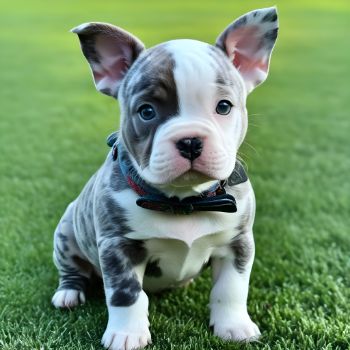
• Naturally Affectionate and Loyal:
Contrary to their intimidating appearance, Merle bullies are renowned for their affectionate and devoted nature.
They thrive on human companionship and adore spending time with their families.
This loyalty extends to children, making them surprisingly gentle and playful companions for young ones when adequately socialized.
• Socialization Importance:
Early socialization is crucial for Merle American Bully dogs to ensure they develop positive interactions with people and other animals.
Exposure to various environments, sounds, and situations helps shape a well-adjusted and socially competent dog.
• Energetic and Playful:
Merle bullies possess a boundless energy that needs to be channeled through active play and exercise.
They enjoy engaging in interactive games, like fetch or tug-of-war, and thrive in environments with ample space to run and expend energy.
• Eager to Please and Trainable:
Merle bullies are intelligent dogs with a strong desire to please their owners. Early socialization and training ensure their well-rounded development and prevent potential behavioral issues.
• Protective Instincts:
Merle bullies possess protective solid instincts and are naturally alert to their surroundings. While this makes them excellent watchdogs, it can lead to territorial behavior if not properly managed.
Consistent training and socialization are essential to channel their protective instincts in a positive and controlled manner.
• Potential Challenges:
Like any breed, merle bullies can present particular challenges:
‣ Strong Prey Drive:
Their strong hunting instincts can lead them to chase after small animals, requiring careful supervision and leash training during walks.
‣ Potential Stubbornness:
While generally eager to please, Merle bullies sometimes exhibit stubbornness, demanding consistent and patient training.
‣ Over-Protectiveness:
Their strong protective instincts can manifest as aggression towards strangers or unfamiliar situations if not properly socialized and trained.
Merle Bully Health Issues:
While bully Merles’ captivating merle coat and powerful physique draw many admirers, potential owners must be aware of potential health issues associated with this unique genetic trait.
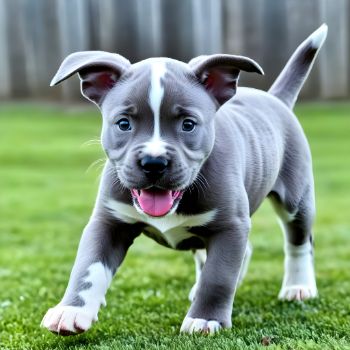
• Deafness:
This is a prevalent concern in double-middle bullies, leading to varying degrees of hearing loss or complete deafness.
• Blindness:
Eye defects like microphthalmia (small eyes) and colobomas (holes in the iris) can lead to partial or complete vision loss in double merle bullies.
• Skin Issues:
Increased sensitivity to sunlight and predisposition to skin allergies are potential concerns for merle bullies.
• Joint Problems:
Hip and elbow dysplasia are common issues in larger breeds, including bully merles, causing pain and mobility limitations.
• Cardiac Issues:
Although less frequent, some bull merles may be predisposed to certain heart conditions.
• Dental Issues:
Crowded teeth and predisposition to periodontal disease are common concerns in bully breeds, requiring regular dental care.
• Obesity:
With their muscular build and love for food, bullies are prone to obesity, which can exacerbate other health issues. Maintaining a healthy weight through diet and exercise is crucial.
Caring for a Merle Bully:
Bully Merles has a unique personality and specific needs requiring dedicated care and understanding.
⚫ Meeting their Physical Needs:
• Nutrition:
Provide a well-balanced diet rich in protein and essential nutrients to support their muscular development and overall health. Consult your veterinarian for personalized recommendations based on your dog’s age, activity level, and needs.
• Exercise:
Bully Merles possesses boundless energy and requires regular exercise to prevent pent-up energy and potential behavioral problems. Engage them in interactive activities like fetch, tug-of-war, and walks to fulfill their physical and mental needs.
• Grooming:
While their short coat requires minimal brushing, regular grooming helps maintain skin and coat health. Bathe them only when necessary, and use mild, dog-specific shampoo to avoid skin irritation.
• Dental Care:
Dental hygiene is crucial for their overall health. Brush their teeth regularly and provide chew toys to help maintain clean teeth and prevent dental issues.
⚫ Nurturing their Emotional Well-being:
• Socialization:
Early socialization is crucial for these dogs to develop into well-adjusted and confident companions. Expose them to various people, animals, and environments from a young age to prevent fear and aggression.
• Training:
These dogs are intelligent and eager to please, making them highly trainable. Utilize positive reinforcement methods like praise and treats to encourage good behavior and build a strong bond.
• Mental Stimulation:
Active their minds with interactive toys, puzzle feeders, and training sessions.
• Affection:
These dogs thrive on human companionship and love. Dedicate time to cuddle, play, and simply be present with your furry friend.
How do you make a Merle bully?
Creating a Purebred Merle American Bully involves understanding the genetics behind the merle coat pattern.
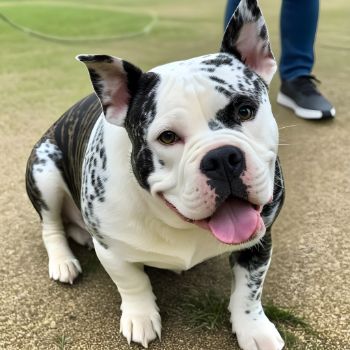
One common misconception is that producing two Merle Bullies will consistently result in Merle puppies. However, this is only sometimes the case, as the merle gene operates semi-dominantly.
Also, unethical breeders exploit the breed’s popularity by using merle bully logo.
To produce Merle American Bully puppies, breeders typically pair a merle-coated dog with a non-merle dog. It increases the likelihood of passing the merle gene without raising the risk of potential health issues associated with double merle breeding.
Misunderstandings about this breeding process can lead to unintentional double merle matings, emphasizing the importance of informed breeding practices.
Ethical Breeding:
Ethical breeding prioritizes the health, temperament, and overall well-being of Bully Merles, moving beyond the allure of their unique coat pattern.
The Merle Bully Breeding Chart acts as a roadmap for ethical breeders, offering insights into the genetics behind the Merle coat. It involves:
• Genetic Testing:
Identifying Merle gene carriers prevents double Merle breeding and minimizes potential health risks.
• Health Screening:
Conducting thorough health checks for both breeding parents to ensure they are free from inheritable diseases. Responsible breeders pay close attention to the quality of reproductive elements, including merle bully sperm.
• Temperament Evaluation:
Select breeding pairs with stable and well-rounded temperaments to produce puppies suitable for families.
• Conformation Adherence:
Prioritizing dogs with physical structures conforming to healthy development breed standards.
• Transparency and Openness:
Providing information about lineage, health testing results, and breeding practices to potential owners.
• Commitment to Welfare:
Ensuring the well-being of breeding parents and puppies throughout their lives, including proper socialization, nutrition, and veterinary care.
To promote responsible practices, you can contribute to ethical breeding by using Merle bully hashtags in your social media posts.
Is Merle Coat Acceptable in the American Bully Breed?
The Merle coat is a recognized but controversial pattern within the American Bully breed community.
However, opinions on its acceptability are divided due to potential health considerations associated with the Merle gene.
• Acceptance in the bully American Community:
In some segments of the American Bully community, the Merle coat is accepted and even sought after for its distinctive appearance.
• Health Concerns and Controversies:
However, the acceptability of the Merle coat is met with controversies, mainly centered around potential health risks associated with double Merle breeding.
• Official Breed Standard and Merle Exclusion:
The official American Bully breed standard, established by the American Bully Kennel Club (ABKC), does not recognize the Merle coat pattern as acceptable.
Merle-coated American Bullies are disqualified from conformation shows and cannot be registered with the ABKC.
Is it advisable to continue breeding Merle American Bullies?
While the mesmerizing swirls hold undeniable appeal, concerns about potential health risks necessitate a discussion before determining whether continued breeding is advisable.
Despite the health risks, some argue for the continued breeding of Merle American Bullies. Their arguments include:
• Enhancement of breed diversity:
Accepting the Merle coat could expand the breed’s genetic pool and introduce new color variations.
• Demand for the Merle coat:
The Merle pattern remains highly sought-after by some breeders and enthusiasts, creating a market for these dogs.
• Natural color variation:
The Merle gene is present in various dog breeds; some consider it a natural and desirable color variation.
• Balancing Health and Appearance:
It is finding the right balance between maintaining the desired breed characteristics and prioritizing the health of Merle American Bullies. It requires collaboration between breeders, breed clubs, and canine health organizations.
‣ Continued research:
Investigating the long-term health effects of the Merle gene and developing strategies to minimize risks.
‣ Stricter breeding regulations:
Implementing stricter rules and guidelines for breeding Merle American Bullies, focusing on health testing and responsible practices.
‣ Education and awareness:
Promoting education and understanding about the potential health risks associated with Merle breeding among breeders, pet owners, and the general public.
By combining these measures, we can create a more responsible and ethical environment for breeding American Bullies, prioritizing their health and well-being over the allure of the Merle coat pattern.
Are Merle American Bullies Related to Pitbulls?
While Merle American Bullies and Pitbulls are muscular and often playful, their relationship could be more complex.
• Genetic Origins:
Merle American Bullies and Pit Bulls share a historical connection rooted in common ancestry.
Both breeds trace their genetic heritage to various bulldog and terrier breeds, initially developed for bull-baiting and later as working and companion dogs.
• Historical Ancestry:
Both breeds share a common ancestor in the Old English Bulldog, a powerful breed used for bull-baiting and other blood sports.
This shared ancestry contributes to their physical similarities, including their muscular build and strong jaws.
• Evolution of Breeds:
As blood sports were outlawed, the Old English Bulldog evolved into two distinct lines: the American Bulldog and the Staffordshire Bull Terrier.
These lines further developed into the American Pit Bull Terrier (Pitbull) and the American Bully.
Merle bully Puppy:
Merle baby bullies are not just adorable bundles of fur with mesmerizing coats but also loving and loyal companions.
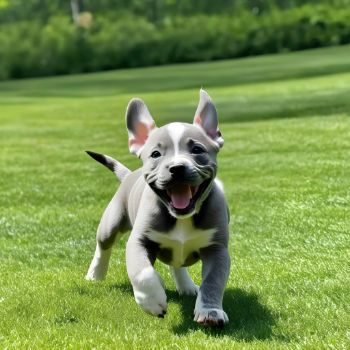
Their distinct swirls of color set them apart from other puppies, making each one a truly unique individual. But their charm goes far beyond aesthetics.
They inherit the playful and outgoing nature of American Bullies. They are energetic and eager to please, seeking attention and affection from their families.
They love to engage in playtime, go for walks, and participate in interactive activities. Their infectious enthusiasm brings joy and laughter to any home.
The Merle baby bully’s affectionate personality is one of its most endearing traits. They thrive in loving environments and develop strong bonds with their owners.
Their loyalty and devotion make them ideal companions for individuals and families seeking a dedicated and cuddly friend.
While individual sizes may vary, American Bullies grow into medium to large dogs with sturdy physiques.
A Merle Bully litter refers to a group of puppies born from the same parents with the merle coat pattern. These litters can showcase a delightful array of coat colors and patterns, adding to the charm of the this breed.
When considering a litter, it’s essential to inquire about the breeding practices of the responsible breeder.
Double Merle bully:
Double Merle Bullies, also known as “lethal whites,” are born when two Merle-coated American Bullies are bred. While their predominantly white coats with patches of color are captivating, double Merle dogs face significant health risks due to inheriting two copies of the Merle gene.
Breeding two merle-coated dogs raises concerns about potential health issues associated with the merle gene. Double merle bullies have an increased risk of congenital abnormalities, including deafness, blindness, and other developmental challenges.
Merle bully cost:
Like any other dog, its cost can vary based on several factors. These factors include the breeder’s reputation, the dog’s pedigree, coat color, size, and overall quality.
Merle Bully bloodlines play a significant role in determining the price, with puppies from champion lines commanding significantly higher prices than those from unknown or working lines.
On average, you can expect to pay anywhere from $1,000 to $3,000 for a Merle Bully fully grown.
Comparing Merle Bully with Other Breeds:
| Characteristic | Merle Bully | American Pit Bull Terrier | American Staffordshire Terrier | English Bulldog | Catahoula Leopard Dog |
|---|---|---|---|---|---|
| Coat Pattern | Merle (marbled effect) | Various, solid colors | Various, solid colors | Short, smooth coat | Merle or Leopard Spots |
| Size | Medium to Large | Medium to Large | Medium to Large | Medium to Large | Medium to Large |
| Temperament | Friendly, Affectionate | Affectionate, Energetic | Confident, Good-natured | Docile, Willful | Intelligent, Energetic |
| Exercise Needs | Moderate | High | High | Low to Moderate | High |
| Health Considerations | Potential for Deafness, Vision Issues with Double Merle | Generally Healthy | Generally Healthy | Respiratory Issues, Hip Dysplasia | Generally Healthy |
| Origin | United States | United States | United States | England | United States |
| Purpose/History | Companion, Show Dog | Originally Bred for Farm Work, Later as a Fighting Dog | Originally Bred for Farm Work, Later as a Show Dog | Originally Used in Bull-Baiting, Later as a Companion | Originally Bred for Hunting and Herding |
Size Categories:
• Pocket:
Pocket American Bullies are compact and more petite, showcasing a muscular build within the height range of 13 to 17 inches.
• Micro:
Micro-American bullies are exceptionally small, even tinier than Pocket dogs, and often sought after for their miniature size but may require careful health considerations.
• Classic:
Classic American Bullies strike a balance in size, maintaining moderate proportions without extreme features, offering a more traditional appearance.
• Merle Bully XL:
Bully Merle XL dogs are Extra Large, emphasizing a massive build while displaying the distinctive Merle coat pattern, contributing to their unique and eye-catching appearance.
Merle XL Bully Blue Eyes:
Merle XL Bully Blue Eyes dogs not only exhibit an Extra Large size and a distinctive merle coat but also feature captivating blue eyes, adding a layer of allure to their appearance.
Hybrids and Exotics:
Within the American Bully breed, the mesmerizing Merle coat pattern adds a captivating layer of diversity.
However, questions often arise regarding “Merle Hybrids” and “Exotic Merle Bullies.” Here’s a breakdown of these terms:
• Exotic bully merle:
This phrase is frequently used interchangeably with “Merle Bully,” but it could suggest a dog that arises from breeding an American Bully with another breed that displays the distinctive Merle coat pattern.
Examples include mixes with Australian Shepherds, Border Collies, or Catahoula Leopard Dogs.
Identifying specific breeds involved in such crosses can be challenging without reliable parentage information.
• Merle hybrid bully:
This term often refers to American Bullies with exaggerated physical features, such as shorter snouts, rounder heads, and smaller stature, exceeding established breed standards.
The term “Exotic” can be misleading as it doesn’t necessarily reflect breed purity or official recognition.
When adorned with the Merle coat, these Bullies can be visually striking but may face health concerns associated with extreme physical traits.
Why do Kennel Clubs not recognize the Merle bully?
While Merle Bully Pitbulls capture hearts with their unique coats and playful personalities, Kennel Clubs remain hesitant to recognize them.
This decision stems from several key factors:
• Non-Historically Occurring Coat:
The Merle pattern isn’t historically found in the Pitbull lineage, raising concerns about preserving the breed’s standard.
• Potential Health Issues:
The Merle gene can lead to health challenges, prompting Kennel Clubs to prioritize the well-being of dogs.
• Responsible Breeding Concerns:
Popularity has attracted unethical breeders, leading to poor choices and health risks. Kennel Clubs aim to discourage such practices.
• Breed Purity Standards:
Strict breed standards must be considered, potentially requiring adjustments for a new coat variation.
• Maintaining Breed Identity:
Recognizing Merle could dilute the Pitbull’s identity. Kennel Clubs prioritize preserving the breed’s distinct characteristics.
Purpose:
With its captivating coat and playful personality, the Merle Bully Pit thrives in various roles.
• Companion:
It’s distinctive coat and friendly demeanor make it an exceptional companion, seamlessly integrating into family life with its affectionate nature and loyalty.
• Working Dog:
It can be trained for specific tasks such as herding or guarding, showcasing its versatility and adaptability as a working dog.
• Show Dog:
Its unique qualities extend to the show ring, where it competes as a conformation show dog, displaying its physical attributes and conforming to breed standards with grace and elegance.
Types of American Merle Bullies by Coat Color:
Various types of bullies have merle coats. In considering coat variations, using a Merle bully color chart can aid in identifying them.
Bully Merle Lilac:
The Bully Merle Lilac features a pale, diluted shade of purple. The Lilac Merle pattern creates a soft and delicate appearance, making these dogs highly sought-after.
Its coat exhibits a soft lilac hue with a distinctive merle pattern. They are known for their calm and affectionate personalities, often thriving in quiet environments.
Lilac Merle Bullies are considered a rare Merle color, which can be more expensive and may require extensive searching to find reputable breeders.
Bully merle black:
It features a black base coat with patches of grey and tan, creating a striking contrast. The Black Merle pattern offers a bold and sophisticated look, showcasing the dog’s muscular physique.
Its coat combines the richness of black with the intricate merle markings. They are known for their intelligence and trainability, making them suitable for various activities.
Although not as common as other Merle types, Black Merle Bullies are gaining popularity among individuals seeking a dramatic, eye-catching appearance.
Red Merle bully:
It has a reddish-brown base coat with patches of black and tan. Its coat displays a warm and vibrant red hue, often with a mix of lighter merle markings.
Red Merles are known for their energetic and spirited nature, mirroring the warmth of their coat color.
They are less common than Blue Merle Bullies but still readily available from responsible breeders.
Blue Merle bully:
The most common type of Bully Merle is characterized by a blue-grey base coat with patches of black and tan.
Its coat showcases a cool, sleek blue-grey hue, often with darker merle markings.
The blue merle pattern can range from subtle to bold, with swirling patches and speckles of color. They are trendy and widely available from reputable breeders.
Bully Merle chocolate:
The Bully Merle Chocolate features a rich, brown base color adorned with a distinctive merle pattern. Its coat exudes a deep, luscious chocolate brown, often enhanced by lighter merle accents.
Chocolate Merles are known for their sweet temperament, aligning with the warmth of their coat color.
The Chocolate Merle pattern can range from deep brown to lighter shades, offering a unique and visually appealing aesthetic.
Light Merle bully:
Light Merle Bully has a light-colored base coat, such as cream or white, with subtle patches of color combined with the merle pattern.
The Light Merle pattern often appears faded or washed out, creating a delicate and ethereal aesthetic. Light Merle Bullies may be more prone to sun sensitivity due to their more golden coat color.
They require careful breeding practices to maintain their unique appearance.
Leopard Merle bully:
Large, well-defined patches of color characterize it on a lighter base coat, resembling a leopard’s spotted pattern.
The Leopard Merle pattern is bold and visually striking, making these dogs stand out among other Merle variations.
Although not as common as different Merle types, Leopard Merle Bullies are gaining popularity due to their unique and exotic appearance.
Merle Brindle bully:
It combines the Merle pattern with a brindle coat pattern, creating a complex and visually captivating appearance.
The Merle Brindle pattern features swirling patches of color overlaid on a brindle base, showcasing a range of shades and textures.
They are known for their strong and athletic build, often excelling in sports and physical activities.
Cryptic Merle Bully:
The Cryptic Merle Bully has a coat where the merle pattern is not immediately evident due to its subtle and subdued appearance.
Its coat may initially appear solid in color, but subtle merle markings become apparent upon closer inspection.
They inherit the Merle gene but express it minimally, potentially impacting breeding practices.
Pros:
- Visually striking and sought-after
- Loyal and devoted companions
- Playful and energetic
- Trainable and adaptable
- Diverse coat colors and patterns
Cons:
- Potential health risks
- Higher prices due to rare coat patterns
- Increased grooming needs
FAQs
Are Merle bullies more expensive?
Yes, Merle Bullies are often priced higher than their non-merle counterparts due to the uniqueness and popularity of their distinctive coat patterns.
Do all Merle Bullies have health issues?
While the Merle gene itself doesn’t cause health issues, breeding practices and the possibility of double Merle combinations can lead to specific health concerns.
Do Merle Bullies require special care compared to other Bully breeds?
While the general care for Merle Bullies aligns with that of other breeds, giving extra attention to coat maintenance is often necessary. Prioritizing responsible breeding practices is essential for ensuring the overall well-being of these unique dogs.
Conclusion:
The Merle Bully, with its mesmerizing coat and playful personality, has captivated hearts worldwide. Yet, beyond the beauty lies a responsibility to ensure the breed’s health and well-being.
By prioritizing ethical breeding practices, responsible ownership, and appreciation for their unique qualities, we can give them the assets to help these dogs continue thriving as cherished companions for generations.
Remember, their value lies not solely in their coat but in the unwavering loyalty and love they offer their families.

